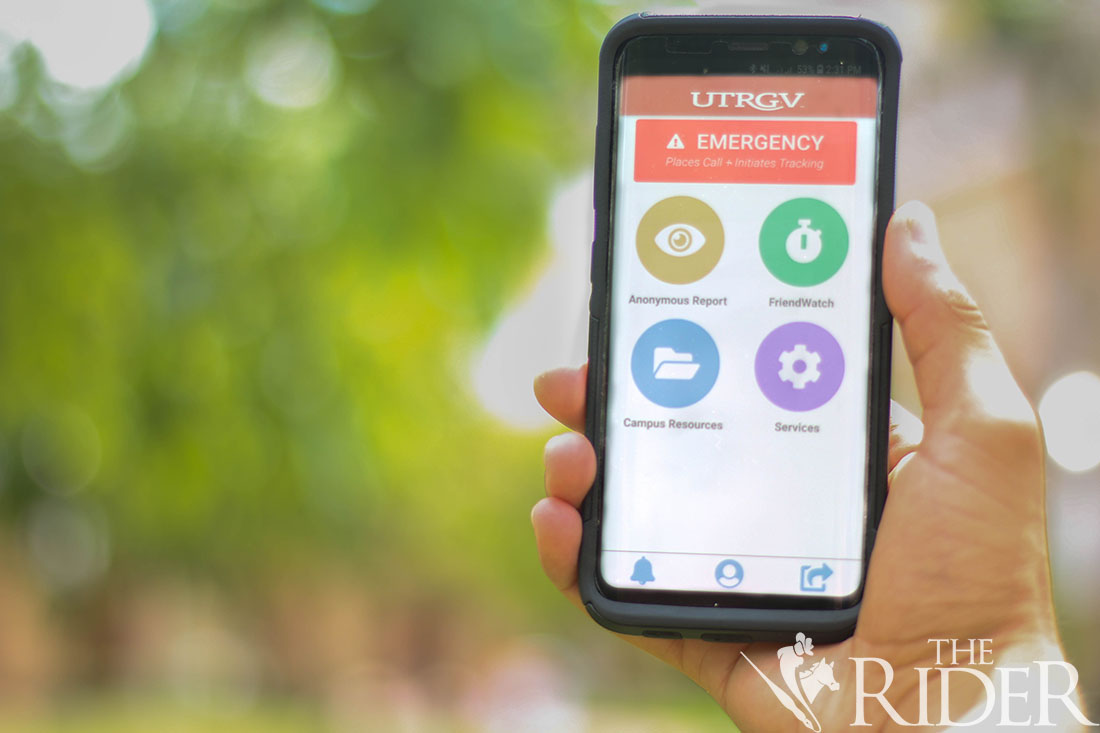
The UTRGV Police Department has launched a new emergency app that aims to increase and ensure safety on campus.
As reported in The Rider on Aug. 27th, the department introduced CampusShield, a free app that has key features, including an emergency button, anonymous report option, FriendWatch, Safe Walk and shuttle schedule.
Police Chief Raul Munguia said the app will function similarly to the Blue Light Emergency Phone. These emergency alarm stations were located on both Brownsville and Edinburg campuses; however, CampusShield is on a cellphone.
“Basically, what it is, [it’s] more of a replacement for the phasing out of the blue phones that are around campus,” Munguia said. “One thing with those blue phones is that they are old technology. I know some of them were based on the 2G network that ceased to exist about 10 months ago.”
Munguia said that during the last three years, the only phone calls the Blue Light Alarm System received were prank calls and one false report.
More than 100 crimes were reported to the University Police on both Brownsville and Edinburg campuses during 2016, according to the Annual Security and Fire Safety Report 2017.
The CampusShield provides various features:
–Emergency button sends the user’s location information to an emergency contact number
–Anonymous Report helps users report safety concerns, suspicious activities and crime tips
–FriendWatch sets a timer to notify the user’s friends or family members once the timer reaches 00:00
–Campus Resources links the person to the Student Services web page on the utrgv.edu website
–SafeWalk lets the user request a safety escort from the University Police or UT Public Safety security
–Campus Maps helps access the Edinburg and Brownsville campus maps
–Bus Schedule links the users to the Parking and Transportation Services web page on the utrgv.edu website
Despite all the features, history sophomore Alfonso Lopez said there could be some unforeseen issues with the app.
“[With FriendWatch], I foresee a lot of false alarms happening when people forget about it,” Lopez said. “It’s a good concept but not very practical.”
However, marketing sophomore Allan Galvan thinks the app is a good idea.
“I never heard of that app and that could have been very useful for me because I’m new to this school,” Galvan said. “I’m an exchange student from Mexico and I got lost like five times the first two days I was here, so it could’ve been a good help for me.”
In case of an active shooter event, the app also allows the police department to locate the threat by tracking the calls from the users in distress.
“Say if we get people … calling in about an active shooter, [if] they don’t tell us where they’re at, we will be able to tell where they are located on campus and this app will also tell us what floor they are on,” Munguia said. “This will be a time-saver in the event of an active shooter event, as long as the students use it and call us, using this particular app.”
The app does not track the user’s location unless the emergency button is pressed.
The Rider asked Munguia how much the app cost. He replied, “We’re not going to talk about money”, and referred The Rider to the purchasing department.
The UTRGV Police Department also offers the Civilian Response to Active Shooter Events (CRASE) training. The course is aimed at enabling civilians involved in an active shooter event within a campus environment to respond efficiently, safely and decisively, according to the UTRGV website.
“It explains what an active shooter is,” Munguia said. “It also explains what the normal reaction of a person is who has never been or involved or is not used to guns. … It teaches them what to do in an event of an active shooter.”
For more information about CampusShield, visit the UTRGV Police Department’s website at utrgv.edu/police.





